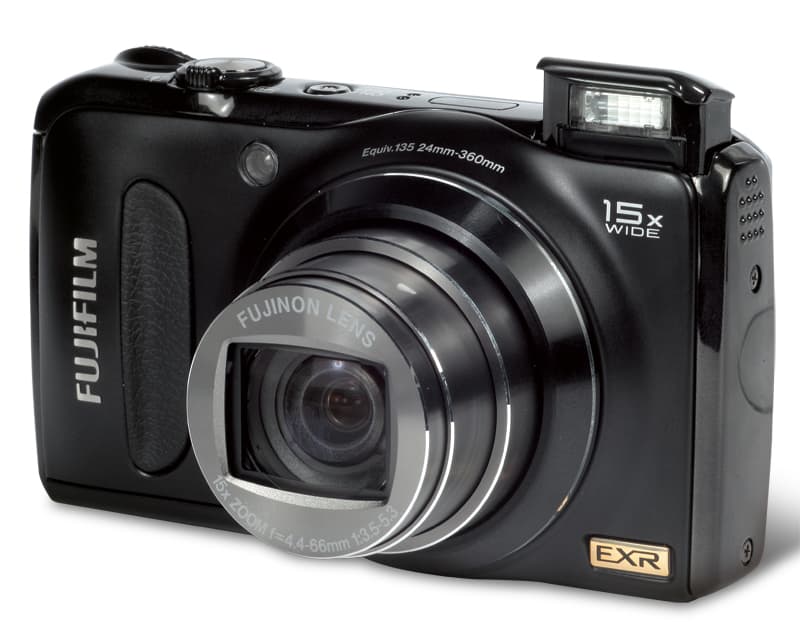This latest incarnation of Fujifilm’s Super CCD sensor, used in the FinePix F300 EXR, has an intriguing new trick up its sleeve: it uses some of the photosites on its 12-million-pixel sensor to allow phase-detection autofocus.
Unlike contrast-detection AF, phase detection works by splitting the light entering the lens into two. The two beams of light then create left and right images on the AF sensors. These images are compared and the lens adjusts according to how out of phase they are with each other. For an easy analogy, think of how a rangefinder camera is focused manually, except that in this case two sensors and a motor calculate the point where the two offset images will meet.
However, the ingenuity of the F300 EXR doesn’t stop there. It has a 15x optical zoom lens – the equivalent of a 24-360mm in 35mm terms – made possible through the use of what Fujifilm calls Double Sliding Structured Lens Technology. This basically means that two different internal lenses automatically slide into place to allow the wide or telephoto capabilities.
Performance
 In use, the zoom lens performs well, taking less than two seconds to go from 24mm to 360mm. Impressively, the zoom control is very smooth and it isn’t noticeable when the internal sliding lenses are switched. With such a long focal length, the camera naturally features in-camera sensor stabilisation, and with the lens zoomed to 15x I was able to achieve acceptable shots when shooting at shutter speeds as long as 1/20sec.
In use, the zoom lens performs well, taking less than two seconds to go from 24mm to 360mm. Impressively, the zoom control is very smooth and it isn’t noticeable when the internal sliding lenses are switched. With such a long focal length, the camera naturally features in-camera sensor stabilisation, and with the lens zoomed to 15x I was able to achieve acceptable shots when shooting at shutter speeds as long as 1/20sec.
The new hybrid phase-detection AF focuses the lens accurately, and is faster than most other contrast-detection AF systems. It is slower at the telephoto extreme, but snappy at wider settings. Yet while the phase-detection AF technology in the EXR sensor is certainly a step forward, it doesn’t match a DSLR.
Contrast-detection AF is also used in the F300 EXR as it can produce more accurate results in low-light conditions. The camera automatically decides which of the two modes to use depending on the scene and the camera’s settings.
As you would expect from a high-end compact camera, there is a range of metering modes, including multi-segment, spot and average. Generally, the multi-segment mode produces good results in both sunny and overcast lighting conditions.
Auto white balance works well in natural sunlight. However, under tungsten light it still leaves quite a strong tungsten colour cast. Switching to the tungsten setting solves this, and in trickier situations a manual white balance mode is available.
Sadly, the camera is only able to shoot JPEG files and there are only five colour settings. Three are named after Fujifilm film: Provia is the standard colour setting and Astia is the neutral or ‘soft’ option.
I found the vivid Velvia setting produced the best results, and is a great choice for snapshots and holiday photos. There are also sepia and black & white image styles available. However, it is a shame there aren’t more user customisation options.
Image quality
At ISO 100 the FinePix F300 EXR performs well, with its 12-million-pixel sensor producing images that are free of colour noise, but include a hint of luminance noise. By ISO 400 noise and noise reduction affects image quality, causing a loss of detail and a smudged appearance to images. At sensitivities higher than ISO 400, results are a little disappointing.
An extended sensitivity of ISO 3200 is available at a reduced six-million-pixel resolution, while ISO 6400 and 12,800 are a meagre three million pixels. Image quality at these settings is quite poor and they should be avoided.
Another concern is that purple fringing affects high-contrast edges, particularly at the corners of images.

The F300 EXR features an impressive 15x optical zoom lens
Our verdict
Fujifilm’s FinePix F300 EXR has some impressive features, with the phase-detection AF and 15x zoom lens taking the plaudits.
However, enthusiast photographers will be disappointed by the image quality and the lack of image colour customisation options. For now, the Panasonic Lumix DMC-TZ10 is the better option.






